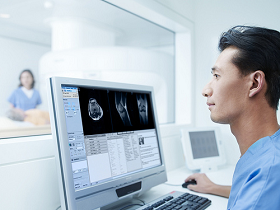A variety of federal legislative activities during 2014 and 2015 contained rulings that will begin to affect Medicare reimbursement to physicians next year. Most recently, The Centers for Medicare and Medicaid Services (CMS) issued its Medicare Physician Fee Schedule (MPFS) Final Rule for 2016 that will govern its payments to physicians. The overall impact of the final MPFS changes to radiology and radiation oncology practices compared with the proposed changes issued earlier this year, is estimated by CMS as follows:
Categories:
radiology reimbursement,
radiation oncology reimbursement,
MPFS,
value modifier,
PQRS,
MIPS,
MACRA
There are relatively few CPT1 coding changes for radiation oncology treatments in store for 2016, at least when compared with diagnostic and interventional radiology. CMS, the Centers for Medicare and Medicaid Services, is still considering and revising a new set of codes for radiation treatment delivery that was proposed in 2015 but not yet implemented. When implementation does occur, these codes will most likely not involve valuation differences, although this in an uncertainty until CMS takes action in some future year.
Categories:
radiation oncology reimbursement,
radiation oncology coding,
brachytherapy
In this blog article that continues our series on how to optimize radiology documentation for maximum reimbursement potential, we address the two most important questions specific to imaging guidance in interventional radiology. Imaging guidance is more and more frequently bundled with the primary interventional procedure, especially with the new CPT[i] codes proposed for 2016. It is, however, still separately billable in certain cases. Regardless of whether it is bundled or not, the radiologist’s documentation for the procedure requires certain elements that thoroughly describe the guidance methods and results. Here are the answers to the two most important questions for your radiology practice to consider.
Categories:
radiology reimbursement,
radiology documentation,
interventional radiology,
imaging guidance
The annual cycle of revising codes in the Current Procedural Terminology1 (CPT)® has been completed with the issuance of the Medicare Physician Fee Schedule (MPFS) Final Rule for 2016, and radiology is one of the areas most affected by the changes. The traditional radiology section of codes, 70010 – 79999, has 60 additions, revisions or deletions and there are even more when the Interventional Radiology (IR) surgical codes are considered.
Categories:
radiology reimbursement,
radiology coding,
interventional radiology,
MPFS,
MRI
Medicare’s required changeover to ICD-10 diagnosis coding has shed more light than usual on a topic that requires constant diligence by radiology practices. Regardless of the payer being billed, good procedure coding and diagnosis coding are a must – and the source material for that coding is the documentation found in the radiologist’s report of the imaging examination.
Categories:
radiology reimbursement,
radiology documentation,
breast imaging,
CT imaging,
3D reconstruction,
ultrasound,
tomosynthesis,
DBT
This concludes our series of articles designed to assist radiologists with the task of preparing their reports for maximum compliance with ICD-10-CM reporting to Medicare. By fine-tuning your documentation you will be assured of the best coding and uninterrupted reimbursement under ICD-10. The complete series is available on our blog page, which also contains additional information to help radiology practices with this major change.
Categories:
radiology documentation,
icd-10
As with any medical procedure, the performance of abdominal ultrasound examinations is defined by specific practice parameters. Likewise, the documentation of those exams must also comply with certain criteria in order for the practice to realize full reimbursement for them. The accepted guideline1 for the performance of abdominal or retroperitoneal ultrasound exams indicates, “Depending on clinical indications, an examination may include the entirety of the abdomen and/or retroperitoneum, a single organ, or several organs.” Similarly, the documentation must contain an exact description of the procedure for proper billing.
Categories:
radiology reimbursement,
radiology documentation,
ultrasound
Healthcare Administrative Partners continues our efforts to help radiology practices make a successful transition to ICD-10 with this article, the third in our series focusing on how radiologists can fine-tune their documentation to assure the best coding and uninterrupted reimbursement. Our previous articles covered Documentation for Pain and Documentation for Fractures and our blog contains additional information to help radiology practices prepare for this major change.
Categories:
radiology reimbursement,
radiology documentation,
icd-10
This is the second in our series of articles designed to assist radiologists with the transition to ICD-10-CM, which will be used in place of ICD-9-CM for reporting diagnoses to Medicare beginning on October 1, 2015. Our goal is to help you fine-tune your documentation to assure the best coding and uninterrupted reimbursement under ICD-10. Our first article covered Documentation for Pain and we also previously posted other information to help radiology practices prepare for this major change. A large number of diagnostic imaging exams deal with the assessment of fractures and the documentation of these exams will require some pieces of information that were not always included in radiology reporting until now.
Categories:
radiology reimbursement,
radiology documentation,
icd-10
By this time, most people working in healthcare are already aware of the deadline to begin using ICD-10-CM in place of ICD-9-CM for reporting diagnoses to Medicare on October 1, 2015. Healthcare Administrative Partners has previously posted information to help radiology practices prepare, and this new series of articles is designed to help radiologists fine-tune their documentation to assure the best coding and uninterrupted reimbursement under ICD-10. One of the major areas of concern for radiologists is in the description of pain for proper diagnosis coding. A survey of historical coding by radiology practices showed that 17 of the 100 most commonly used ICD-9 diagnoses were related to pain.
Categories:
radiology reimbursement,
radiology documentation,
icd-10













